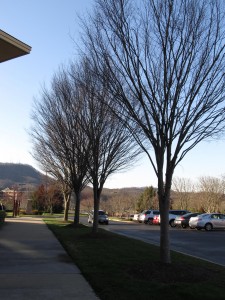Japanese zelkova (Zelkova serrata) is a 60-90 feet tall shade tree with structurally strong branches. Fast growing zelkova may grow 2 feet or more in a single year. Belonging to the elm family (Ulmaceae), zelkova exhibits several elm-like features, including a vase shaped branching habit. Its very different exfoliating mottled bark distinguishes it from elms.
Dark green leaves are 3-5 inches long with blunted teeth along the margin. Leaves turn bronze yellow in the fall, somewhat dependent on the cultivar and previous summer’s growing conditions. Tiny insignificant flowers appear in the spring. Fall seeds are consumed by birds and wildlife, and its dense tree canopy offers shelter to birds.
Zelkova trees tolerates wind, summer heat and drought, and urban air pollutants. Tree form varies from a narrow upright 20 to 25 feet spread of ‘Musashino’ to the wide 40 to 50 feet strongly horizontal branching of ‘Village Green’. Until recently, upright branched ‘Green Vase’ had been a popular favorite for urban/suburban street planting.
Zelkova is best sited in full to partial sunlight (6 hours minimum). Soil should be acid to slightly alkaline, and preferably moist and well drained. Plant either container grown or balled-and-burlapped (b&b) nursery stock. In urban/suburban street plantings irrigate newly planted trees deeply for 2-3 years until established. Feed annually in late winter with 10-10-10 granular fertilizer or equivalent.
Through the growing season, the dark green foliage remains disease or pest free. On rare occasions leaf feeding beetles may cause some defoliation, but fast growing zelkova recovers quickly. The shallow roots of a large zelkova may lift up the sidewalk.


 Posted in
Posted in 
